Losing shade trees and replanting
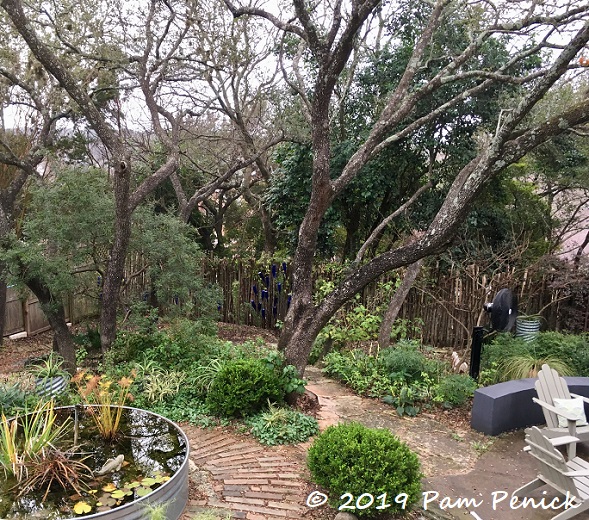
For 10 years I’ve gardened under dozens of live oaks on our 1/3-acre lot. Last month we lost two of our treasured trees (center of photo above), which shaded our patio and one end of the pool from the blazing summer sun. It’s a big loss, and I’m still coming to terms with it.
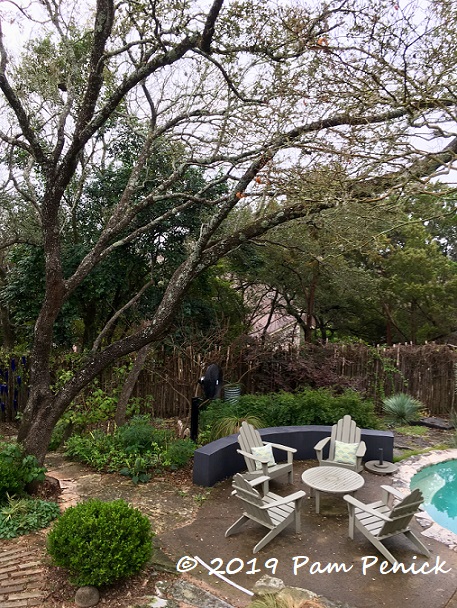
The two trees struggled for the past couple of years. We consulted an arborist, who advised us to fertilize, which we did. The defoliation continued. Last May, when the Garden Bloggers Fling tour visited my garden, I was still fretting over the thin canopy, but I decided to put off further consultations until the fall.
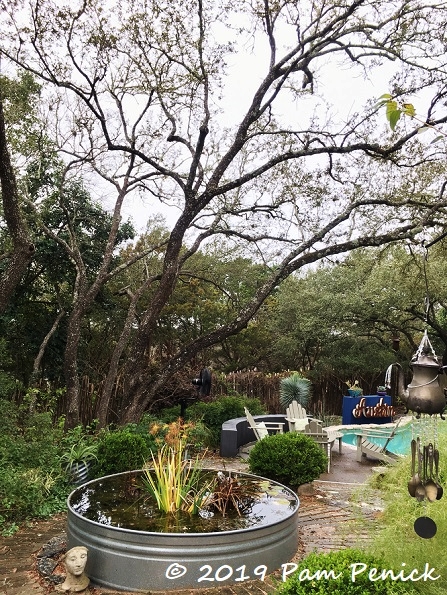
By fall, it was too late. I consulted with four arborists, and all but one advised immediate removal. Even the holdout admitted the odds of saving them were long. I considered trying to keep them going with fertilizer injections, but ultimately the arborist we chose convinced me that it would be better to let the ax fall and move on rather than draw out their decline.
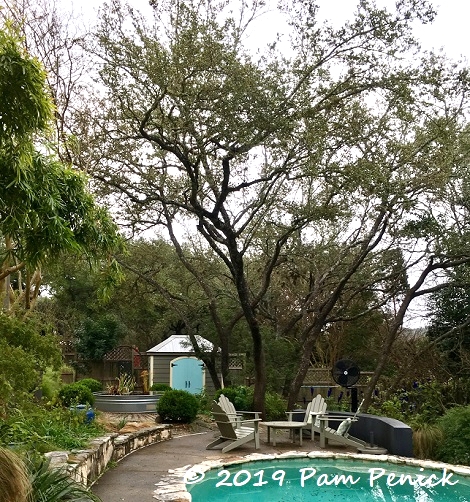
In this photo, taken the day before the removal, the canopy looks fuller and greener than in the previous photos. That’s because two branches hanging over the pool were still relatively leafy. But surrounding branches were nearly bare. They looked like live oaks going through leaf-drop in March — and they’d looked that way for a year.
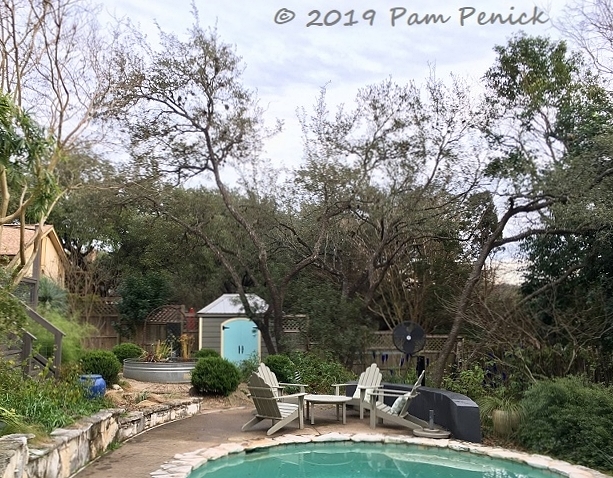
They were cut down in early January. Here’s the devastating “after.” Once the dying trees came out, I could see that the surrounding live oaks looked puny too. Their canopies should be much fuller. But even if they were healthy, there’s now a big hole, and it’s going to be hotter and brighter sitting by the pool for some time to come.
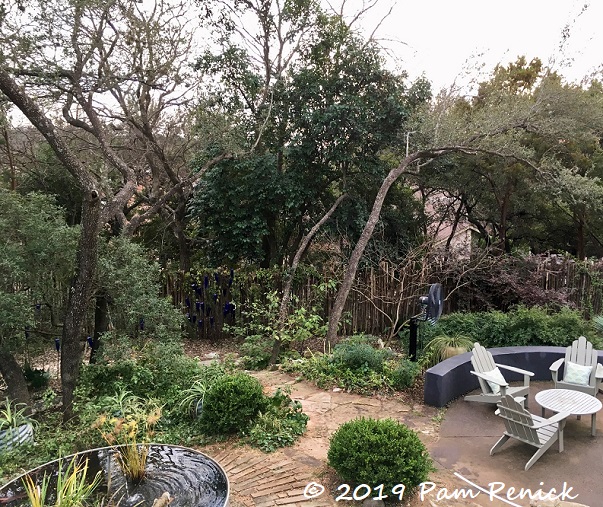
On the bright side — and there’s always a bright side — I now have some sunny spaces to plant up. I’ve had so much shade for so long, and it will be fun to add flowering sun-lovers to the mix. At least until our new tree fills in (see below).
Second, our pool has always been chilly because of all the shade. I like a cool pool, but few of my friends and family are polar bears like me. This summer, the pool will be more comfortable for those not actively swimming to warm up.
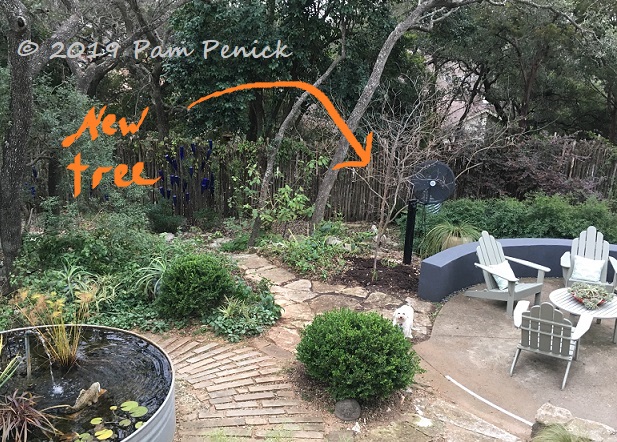
Third, it gave me an opportunity to diversify our live oak-forested property with a different species. After considering the elegant Monterrey oak, I decided instead to plant a cedar elm to the right of the flagstone path, several feet closer to the patio. Not everyone appreciates cedar elm because it tends to make lots of seedlings, and older trees can be brittle (it is, however, long-lived). But I love this native tree for its small toothy leaves that turn golden yellow in autumn, its corky bark, and its upright yet spreading shape.
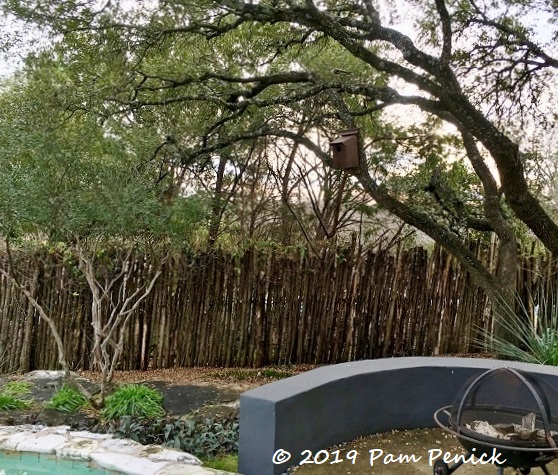
One of the saddest moments of this whole process was realizing we were losing our owl tree — that is, the tree where our screech owl box has sheltered 8 or so generations of owlets and their parents. We could sit at our dining table in the evening and watch through the window as the parents fed the chicks. With that tree gone, the box needed a new location.
A cluster of live oaks at the other end of the pool held promise. One of the tree limbs is nearly vertical (live oaks tend to sprawl rather than strand straight) and faces east, away from the hot afternoon sun. Another plus: I’d be able to view the box from my office window. We hung it up and were thrilled a week later to see a little screech owl perching in the doorway. I hope this means we’ll soon have another owl family in residence.
You may be wondering what happened to our trees to make them decline so rapidly. The answer is in tomorrow’s post. It’s a commonplace practice that may be impacting your own trees and harming them without your even knowing it.
__________________________
Digging Deeper
Come learn about gardening and design at Garden Spark! I organize in-person talks by inspiring designers, landscape architects, authors, and gardeners a few times a year in Austin. These are limited-attendance events that sell out quickly, so join the Garden Spark email list to be notified in advance; simply click this link and ask to be added. Season 8 kicks off in fall 2024. Stay tuned for more info!
All material © 2024 by Pam Penick for Digging. Unauthorized reproduction prohibited.


Wow, I am so sorry. The loss of mature trees is always big and painful, BUT being who you are with your extensive knowledge, I’m certain you selected the right tree, the cedar elem, to replace what you lost…I’m also intrigued by what caused this loss. If it’s a commonplace practice, I’m all ears. I was thinking (initially) hypoxylon canker or oak wilt, but obviously that’s not the case. FYI, I was super surprised to learn that oak wilt doesn’t happen in east Texas or at least that’s what an arborist told me.
I didn’t know that about oak wilt, Laura. Interesting, and lucky for folks in East Texas.
We have a number of trees that are 60+ years old and have a 50 year life span. I’m sure when the owners planted them they couldn’t imagine the property 50 years down the road. It’s sobering to have to lose/remove big trees because they have such a major effect on design to say nothing of light. Looking forward to part 2 of your post.
I’m sure you’re already planning ahead for your tree replacements, Linda. It’s all we can do — that and embrace change when it comes.
Wow, big changes! It must still be shocking to walk outside, or look out a window and have them be gone. I’m glad it seems your local owls haven’t missed a beat.
The shock has lessened, but I’m still getting used to the new look of the garden. But I’m also excited about planting new and different plants. Planting makes everything better!
Oh! Pam. I am sorry. I remember how you lost the one at the front and said you thought the same was happening at the back. I know it must be hard but it will bring new opportunities and some you may really enjoy. We are in the same boat over here. One needs to come down right now and we are looking at others that looks as thought they are going the same way. I fear driveways and house have impacted their roots as well as struggles with drought, heat and hail.
I’m sorry to hear you’re facing additional tree losses too, Jenny. Change is inevitable, and I’m sure you’ll find the upside. Dare I suggest more roses and agaves?
I sympathize, Pam. Removing a tree is always traumatic, even when it opens new opportunities. I’m currently watching over my mimosa, which was reduced by half its size in December. In our case, the cause of the decline, in addition to age, is shot-hole borers and my hope is that removing the infected part of the tree may extend the life of the other half but that’s in no way certain. However, I’m sure your new tree will bring you joy and I’m very pleased to hear that neither you nor your faithful blog audience will be denied photos of the owls!
Our owl visitor definitely cheered me up and made it all seem OK. I hope your mimosa rallies, Kris.
It is SO hard to lose a tree. To lose two — omg. I love that you see a bright side and new opportunities for planting and growing. Like many, I’m eager to hear what common practice caused their demise.
Pat, your own example of turning a downed tree into art is inspiring. It’s all about looking for the opportunity amid the loss.
Gosh, that’s a hard loss. I’m glad to know that you are seeing potential for the space with the change in canopy. And wonderful that you replaced it with a native tree that will add even more color and texture to your garden.
I’m excited about the new tree! The live oaks are lovely and iconic for this part of the state. But I’m eager to see a different native tree in my garden.
So hard to lose two large trees like that, but hope that your native addition will work well.
I so hope that your screech owls adjust to a new location! Wouldn’t it be great to see them out your office window, indeed?
Yes, I would gladly welcome that distraction from my work. 🙂
Trees do become like members of the family. Looking forward to part II, because the background oaks look in good shape, so it can’t be insects or disease but something about planting near their trunks…? or the hardscape heating up the roots…?
Close, Denise. I’ll post the follow-up tomorrow and solve the mystery.
When one door closes, another one opens. I hope the newly found sunshine brings you happy opportunities.
I’m sure it will. 🙂
i agree with diana… all the best
Oh my, losing not one but two trees. The garden will feel odd until you get used to it. You have to think positive like that little owl. Something else will eventually fill in. I like your choices of trees. Something different and interesting. Can’t wait to read part 2.
That owl brought me such joy. I am sure the new sunnier garden spaces will too.
Did you consider keeping a snag? I understand screech owls enjoy nesting in them.
We live in Colorado now and recently lost an aspen to old age and a beautiful blue spruce to beetles. As sad as I was to see those two die, we left the snags (we removed the infested section of the spruce, reducing her footprint, which also allowed us to plant another tree nearby). These spots are still my favorite places in our garden. So many woodpeckers!
It’s true that snags (standing dead trees or trunks) are considered valuable wildlife habitat. Perhaps if our garden were larger and the trees were located away from the house we could have considered that option. But these trees hung right over our patio and were prominent from every angle.
Just saw this post when I headed over to your blog after seeing what you had to say about this week’s late freeze (3/3-3/4). I’m sorry for your loss, but excited for your gains. I appreciate that you blog about exactly this kind of thing that we have to deal with from time to time as gardeners–abrupt changes that we don’t choose for ourselves, and how to cope.
My two backyard neighbors just cleared and ground up every stick of Ashe Juniper that formed the small forest behind our house, leaving only a few sparse and straggly oaks behind. So, we’re going from dense to dappled shade this year (the row of mixed small trees on our side of the fence is still standing). I’m not thrilled to lose the privacy, but I am excited about the new planting possibilities to solve our privacy problem again.
I love cedar elms. We had two lovely cedar elms, one medium (25 feet or so) and one large (70+ feet), framing our old backyard in NW Austin. I didn’t mind the seedlings so much, and I loved the delicate golden rain of leaves in the fall. Makes great compost, too. I planted one about 3 years ago here in Dripping Springs; I’m waiting to see when (or if) will “leap”, but it’s been plodding along nicely so far.
I’ll be following the changes in your garden, as I track the changes in mine. 🙂
Thanks for your encouraging and thoughtful reply, Mary. Your loss of neighboring junipers is one that I’ve long dreaded, as we too enjoy a green view of neighboring junipers in a little greenbelt between our house and the one behind us. So many people hate junipers (cedars) that they always seem in danger of being cut down. Our over-the-fence neighbor recently removed some trees and put up a big, beige tarp-covered parking area for an antique car — right behind our fence. We’re rarely in control of the views we enjoy. All we can do is keep planting on our side of the fence.